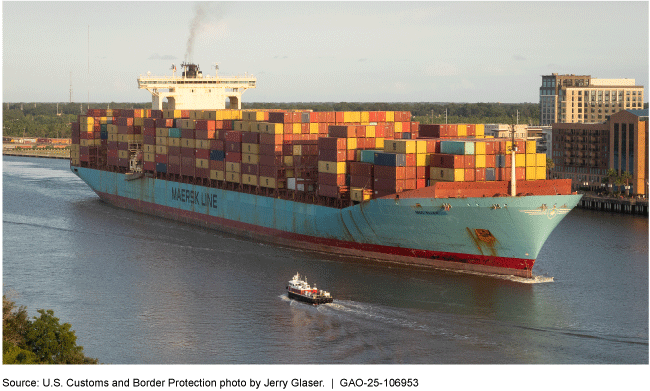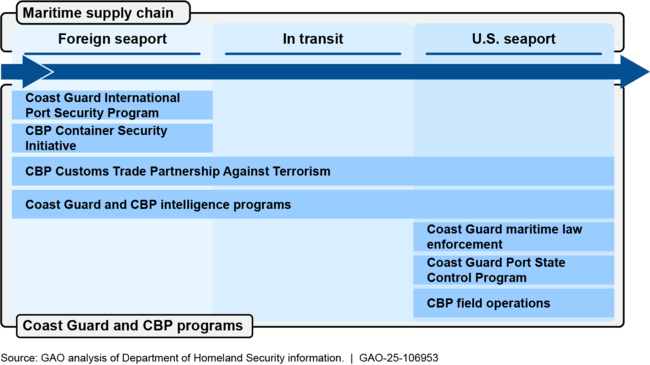Maritime Cargo Security: Additional Efforts Needed to Assess the Effectiveness of DHS's Approach
Fast Facts
The U.S. economy depends on the efficient flow of millions of tons of cargo each day throughout the global supply chain, most arriving by ship. The Coast Guard and U.S. Customs and Border Protection monitor these vessels for potential national security risks, like smuggling.
At the 8 ports we reviewed, the agencies generally followed selected leading collaboration practices such as "leveraging resources"—like helping each other with vessel boardings during staff shortages.
The Coast Guard has worked with others to develop a strategic goal for maritime security. We recommended that the Coast Guard better measure progress toward this goal.

Highlights
What GAO Found
The Department of Homeland Security (DHS) uses a layered maritime security approach to identify potentially high-risk, U.S.-bound vessels and cargo shipments. Within DHS, the U.S. Coast Guard and U.S. Customs and Border Protection (CBP) are the lead agencies that manage programs that screen, target, and examine these vessels and shipments. Both agencies conduct these activities before vessels and cargo depart foreign seaports, in transit, and upon their arrival at U.S. seaports. For example, both agencies have intelligence programs to screen and target these vessels and cargo across the supply chain.
U.S. Coast Guard and U.S. Customs and Border Protection (CBP) Programs to Secure U.S.-Bound Vessels and Cargo in the Maritime Supply Chain

GAO found that Coast Guard and CBP at the 16 selected field units generally followed five selected leading practices for interagency collaboration in their efforts to secure U.S.-bound vessels and maritime cargo from national security risks. For example, officials from all selected field units we interviewed reported leveraging resources and information to collaborate with their counterpart. Specifically, Coast Guard officials at one location said they leveraged the staff of other federal agencies, such as CBP, to help with vessel boardings due to their own staffing challenges.
GAO also found that DHS had not fully assessed the effectiveness of its approach for securing vessels and maritime cargo. The Coast Guard and Transportation Systems Sector partners—including federal agencies, state, local, and tribal governments, and nongovernmental organizations—identified a strategic goal with activities relevant to securing vessels and maritime cargo. However, they have not developed objective, measurable, and quantifiable performance goals and performance measures to fully assess progress towards this goal. Doing so would better position the agency and its partners to regularly use performance information to assess the effectiveness of their approach and help inform decisions, such as determining how to best allocate resources.
Why GAO Did This Study
The U.S. economy depends on the quick and efficient flow of millions of tons of cargo each day throughout the global supply chain. However, U.S.-bound vessels and maritime cargo shipments are vulnerable to criminal activity or terrorist attacks that could disrupt operations and limit global economic growth and productivity.
The James M. Inhofe National Defense Authorization Act for Fiscal Year 2023 includes a provision for GAO to assess federal efforts to secure U.S.-bound vessels and maritime cargo from national security-related risks. This report addresses (1) how DHS secures these vessels and cargo from supply chain risks, (2) the extent that DHS used selected leading collaboration practices, and (3) the extent that DHS assessed its approach.
GAO reviewed agency policies, procedures, and collaboration efforts and government-wide strategy documents, and assessed DHS collaboration efforts against five relevant leading practices identified in prior GAO work. GAO also interviewed Coast Guard and CBP officials from 16 field locations at a non-generalizable sample of eight U.S. seaports selected for varying volumes of cargo and diversity of geographic regions.
Recommendations
GAO recommends that the Coast Guard, with sector partners, develop objective, measurable, and quantifiable performance goals and measures and use this performance information to assess progress towards the goals and effectiveness of the layered approach to securing vessels and maritime cargo on an ongoing basis. DHS concurred with our recommendations.
Recommendations for Executive Action
| Agency Affected | Recommendation | Status |
|---|---|---|
| United States Coast Guard | The Commandant of the Coast Guard, in coordination with Transportation Systems Sector partners, should develop objective, measurable, and quantifiable performance goals and associated performance measures. (Recommendation 1) |
When we confirm what actions the agency has taken in response to this recommendation, we will provide updated information.
|
| United States Coast Guard | The Commandant of the Coast Guard, in coordination with Transportation Systems Sector partners, should use the performance information collected to assess progress toward strategic and performance goals and the overall effectiveness of the layered approach to securing vessels and maritime cargo on an ongoing basis. (Recommendation 2) |
When we confirm what actions the agency has taken in response to this recommendation, we will provide updated information.
|
